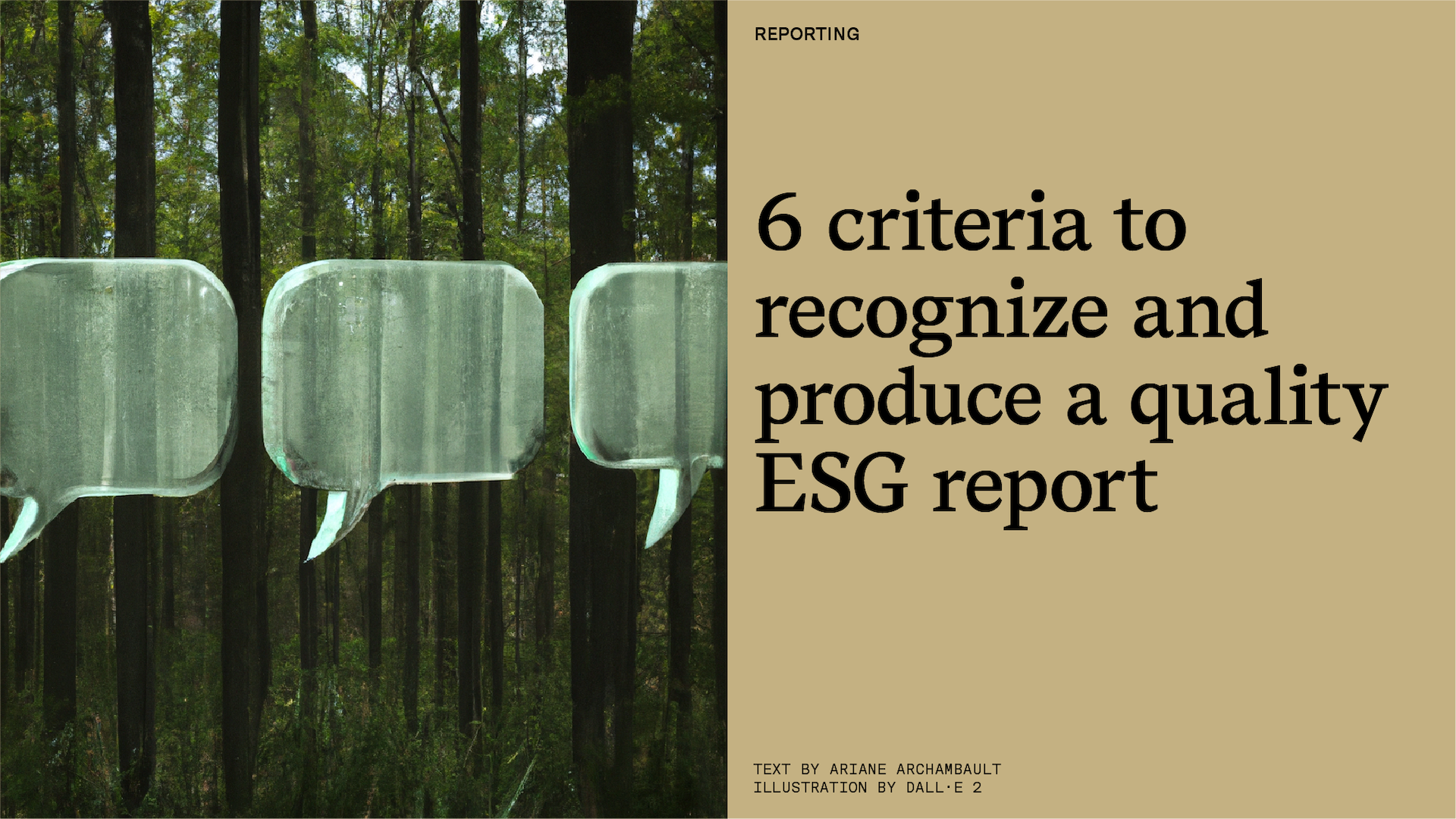
How to create inclusively and avoid the pitfalls of sensationalism with sensitivity?

Environmental, Social, and Governance performance reports—commonly known as “ESG reports”, “Corporate Social Responsibility (CSR) reports”, or “sustainable development reports”—are being seen more and more. (If you’re not quite sure of the difference between the terms we use here, have a look at our last article.).
These reports are part of a company's accountability approach, and are intended for stakeholders—including consumers, partners, suppliers, employees, and investors— who expect a company to be accountable for its level of social and environmental responsibility. Just as companies share their financial statements with their shareholders and bankers, they can benefit from sharing their social commitments and the actions they’ve taken to help create a more fair and more sustainable society. This is known as disclosing extra-financial information.
Although social and environmental accountability is considered essential, not all companies do it the right way—and that’s not entirely their fault. Numerous standards exist to guide companies in their communications, but there is no universal norm. How can we compare companies’ extra-financial communications if they are based on different frameworks? The good news is, it won't be long before those standards exist. In the meantime, though, it is still possible to identify some essential elements that all companies must communicate in order to assess the quality of the various reports.
Measurement is the basis of a credible report. The commitments a company makes must come with specific and measurable actions and objectives. It’s no longer enough to say that a company wants to reduce its waste; it has to set a reduction target that can be reassessed the following year, when the company updates its ESG report.
Measurement is also a requirement for improvement. It’s easy to see a company’s lack of intention if their numbers show no improvement, year after year. With all things considered (including employees and sales), if the amount of waste a company generates stays about the same for three years running, it’s fairly clear that no action has been taken to achieve results that are better.
Beyond measuring progress and improving the commitments a company makes, proportionality is also an important factor. A company can boast of donating $1,000 per year to a non-profit organisation, but it is not really possible to grasp the extent of the company’s commitment from this information alone; if the company makes $3 billion in profit a year, its $1,000 donation is not very meaningful. Similarly, if a company states that 10 of its management positions are held by women, we need to know if that’s of a total of 20 or 100 managers—because if it’s the latter, the company would be far from achieving parity. Showing a measure’s proportionality makes that measurement much more evocative and transparent.
That said, measurements take time, and so does the data collection process. Although quantitative data makes it possible to compare the performance of different companies, for example, qualitative impacts that are often difficult to quantify are just as important and relevant.
Sharing your company’s social and environmental commitments in a report is obviously the basis for good accountability. However, all too often these commitments are not very detailed and have a time frame that is much too vast. Anyone can set goals for 2050. What sets a good commitment apart isn’t necessarily associated with key performance indicators (KPIs) or with timeframe, but rather with explaining the steps you will take to get where you want to go. It’s important to see that the company has a deeper understanding of its material challenges. What are the next steps to take? How does your company plan to achieve its goals?
Sharing far-off targets without providing explanations risks being seen as green or social washing.
Of course, transparency is a key factor in good accountability. Transparency means communicating successes but also shortcomings. Companies will often highlight their successes without dwelling on any brakes or delays. Conversely, if all of your objectives are easy to achieve, the initial ambition might need to be reconsidered.
A better practice is to be clear about delays and even steps backwards, and explain the reasons they happen. This kind of transparency in communications can promote cooperation between different stakeholders who might share the same issues, for example. Communicating in an authentic and honest way also makes it possible to raise public awareness about how complex the procedures are, which keeps people from becoming so cynical that they stop believing in companies’ social commitment.
In terms of visuals, including a graph that shows the year-to-year progress of your company’s objectives is a quick way to communicate progress.
The philanthropy of yesteryear was basically the infancy of what we now know as corporate social responsibility. Not long ago, all a company had to do to boost its image among the general public was donate to a cause or partner with a charity. Now, it takes a lot more for a company to be considered responsible.
Philanthropy will clearly always have its place in an accountability report, but it should not stand in as the entire “social” portion of a company’s ESG criteria. Philanthropy makes it possible to financially compensate for services when public funds are cut; this is called “social change philanthropy”. It’s a model that aims to address social issues at the source, like assisting with social reintegration by financing housing for homeless people. This kind of strategic philanthropy makes possible sustained financial assistance that can ensure an organisation’s survival. The idea isn't to make charities dependent on donations, but rather to get to the source of a problem, with a view to making deeper changes.
There are a number of other initiatives that are relevant to include in the “social” section of your reports, including such things as positive actions made towards increased diversity and inclusion, good working conditions, community commitments, accessibility, and health and safety measures.
Ultimately, companies can have greater social impact through their business model than they can through philanthropy.
As mentioned above, multiple standards already exist to ensure structured reports that allow for comparison between companies (ISO 26000, SASB, TCFD, GRI). Generally, these standards are particularly relevant for publicly-traded companies whose investors require extra-financial disclosure. And which standard to use always depends on the target audience. There is a difference between wanting to make customers aware of a company's good corporate practices through a sustainable development report, and being accountable to investors. Using baselines isn’t always required. Moreover, combining several standards and indicators can better reflect a company’s business context.
The problem is when we see companies stick to the standards by focusing on compliance without necessarily intending to improve their social or environmental impact in any real way. This kind of communication can suggest that the companies don’t understand the rationale behind the standards they’re using, or the importance of accounting for their impact on society.
The majority of companies still produce separate financial and ESG reports. Having these reports as separate elements could suggest that environmental and societal considerations are less important than financial ones. On the other hand, producing an “integrated report” that combines information about a company’s financial, social, and environmental performance shows that these three pillars are seen as an integral part of a company's strategy and values.
If you are ready to take action, you may well be wondering where to begin. Some companies set up an ESG department or committee, whose purpose is to coordinate data collection within different departments and to ensure that actions are taken and measured so that their progress can be communicated. Setting and measuring the objectives is often done with the help of a third-party company specialising in financial and extra-financial audits. In short, companies need a good ESG strategy with clear and measurable objectives as well as a well-developed communications and marketing plan if they want to deliver a credible and relevant report.
If you’d like to find out more about our strategic support service, click here.
Sources
Lacelle, N. (2017). Béati, un modèle de philanthropie alternatif? Accompagner le changement social en le finançant: synthèse. [“Beati: An Alternative Model for Philanthropy? Guiding Social Change by Financing It: A Summary.”]
Lefèvre, S. & Charbonneau, J. (2011). Présentation : philanthropie et fondations privées : vers une nouvelle gouvernance du social ? [“Presentation: ‘Philanthropy and Private Foundations: Towards a New Social Governance?’”], Lien social et Politiques [“The Link between the Social and the Political”], (65), 7–16. https://doi.org/10.7202/1006023ar